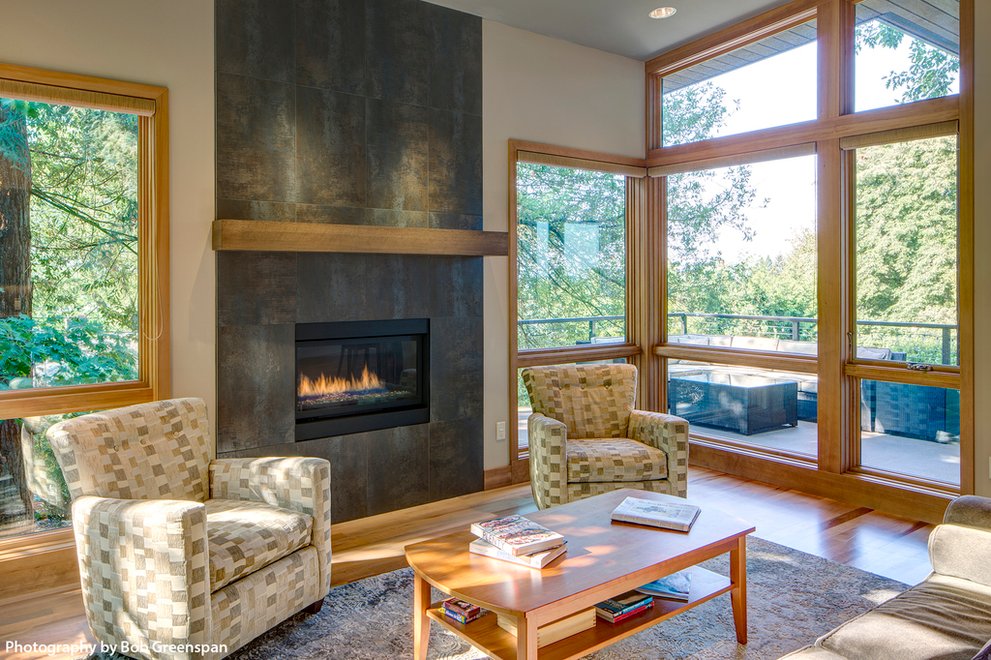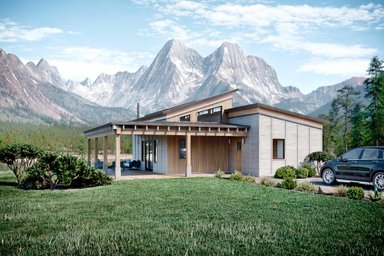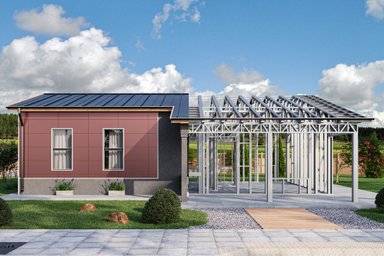It’s the holiday season. If you imagine sitting
with your family and friends by a welcoming fire in your new home, like the one in Plan 48-656, shown above, here’s a
question: In today’s new energy-efficient, green homes, are fireplaces relevant
or a thing of the past?
To Burn or Not to Burn
Most of the architects and designers who weighed in on this topic said that clients want fireplaces for aesthetics rather than home heating, although where the client is located may impact the decision. Boston-based Designer Ben Uyeda, co-founder of ZeroEnergy Design and director of HomeMade Modern says that no fireplace is cost effective. “If you have a well-insulated house that has a good central heating system, a fireplace is an aesthetic, or vanity, choice,” he says. And Michelle Wempe, principal of zumaooh, an Oakland, California-based design practice, says that her clients choose a fireplace for aesthetics, unless it’s outdoors, in which case, it can also ward off a chill. “We haven’t been able to install a wood-burning fireplace in Northern California for years,” she explains. “If you want a fireplace, it has to be a gas appliance.”
However, 75 percent of Brattleboro, Vermont-based Architect Robert Swinburne’s clients want fireplaces or wood stoves for heating. “Wood stoves and fireplaces are allowed as long as they can provide sealed combustion, meaning makeup air, and a sealed firebox,” Swinburne, principal of the Bluetime Collaborative, explains. And Cooter Ramsey, AIA, a principal of Allison Ramsey Architects in Beaufort, South Carolina, near Hilton Head Island, says that 90 percent of his clients want fireplaces. Sixty percent of those that want fireplaces opt for wood-burning ones, while 40 percent choose gas models.
The first question that Uyeda asks clients who want a fireplace is, “Why?” Resale value and functional warmth are the most common answers. When Uyeda explains heat loss, installation costs, and what’s involved in regulatory compliance, most of his clients opt out. On the other hand, for many of Ramsey’s clients, the fireplace is a central point of social interaction for family and friends and its design sets the tone for the interior of the home.
Our experts offer helpful recommendations on masonry, gas and alcohol fireplaces to help you make your decision. (None of the architects and designers interviewed recommend electric fireplaces.)
Wood-Burning Fireplaces
Allison Ramsey Architects still builds traditional masonry fireplaces in a lot of its homes. Most fireplaces have either a 36-inch or 42-inch box depending on the size of the room, Ramsey says. If wood-burning fireplaces are allowed in your area and you decide to install one, make sure it’s an EPA-rated fireplace, adds Swinburne of Bluetime Collaborative. In terms of design, Swinburne prefers the tall, shallow Rumford masonry fireplace
(designed by Count Rumford in the late 1700s and installed at Monticello by Thomas Jefferson; the diagram here is from Renaissance Fireplaces), which allows for maximal heating, and the traditional inglenook fireplace in which a partially enclosed hearth area is added to larger room. While mantels and hearths vary from project to project, Ramsey’s clients often use large reclaimed timbers for the mantel with a slate surround.
When it comes to pre-engineered masonry and metal wood-burning fireplaces, Ramsey recommends the FireRock and Isokern brands. Isokern offers masonry fireplaces, while FireRock provides masonry and metal fireplaces. For looks and efficiency, Solar Environmental Architect David Wright, principal of David Wright Associates in Grass Valley, California, prefers Jotul or Heatilator fireplaces. While each of these brands offers models of pre-engineered fireplaces in sizes ranging from 20 to 72 inches, 36 and 42 inches are the most common widths.
As an added note, when installing a fireplace in new construction, Swinburne also includes a heat recovery ventilator (HRV), which, he says, helps with indoor air quality. However, Tucson, Arizona-based architect Laurie Clark, principal of Modern House Plans, cautions against installing a fireplace inside a home that gets fresh air from controlled mechanical ventilation because it could lead to carbon monoxide poisoning or oxygen depletion, both of which are fatal.
Wood-Burning Fireplace Pros and Cons
There’s nothing like a real wood fire crackling in the fireplace, and it takes special skills to maintain a wood-burning fireplace in a home. “Renaissance men love the smell of the fire and the popping of the wood,” Ramsey says. “It can’t be imitated by gas, and anything less is unacceptable.”
According to the Environmental Protection Agency (EPA) Burn Wise program, wood-burning fireplaces are inefficient (losing most of their heat up the chimney), exacerbate health problems indoors, pollute outdoor air, emitting 28 pounds of particulates per MMBTU, or one million BTUs, of heat output (see their chart below).
Regarding concerns about indoor and outdoor air quality and restrictions on wood-burning fireplaces, Ramsey replies, “All of my clients are concerned with indoor and outdoor air quality, but none of them think that the fireplace is really of any concern in regards to this. Twenty fires a year in your house isn’t causing our issues.” And Swinburne adds, “We’re normally building in rural areas, so outdoor air quality is not a big issue.”
Gas Fireplaces
Gas fireplaces are available as inserts, built-ins or log sets (burners that fit in existing traditional fireplaces). Gas fireplaces, which burn propane or natural gas, are available in direct-vent or ventless models. Direct-vent gas fireplaces vent combustion gasses directly to the outside of the structure in which they are installed. Ventless fireplaces, which are designed to burn clean, allow combustion byproducts to flow into the room in which the fireplace is located.
For gas fireplaces, Wempe of zumaooh recommends Spark Modern Fires fireplaces, which cost between $3,300 and $15000+. Wright suggests Heatilator gas fireplaces, which cost between approximately $1,500 and $5,870+. Both brands offers models in sizes ranging from 20 to 72 inches, with 36 and 42 inches being the most common sizes.
Gas Fireplace Pros and Cons
Gas fireplaces are clean, safe, low maintenance, and easy to operate, Wempe says. Plus, there’s no wood mess in the house, and heat doesn’t escape out the flue like it does with a wood-burning unit, making them much more efficient than traditional masonry fireplaces.
However, it’s hard to run a gas fireplace for long periods without the room getting very warm, Wempe says. And the glass in some units gets hot enough to burn skin, so be sure to install a screen (available from most manufacturers) to keep accidents from happening. Ventless gas fireplaces vent carbon monoxide (which can be fatal), airborne particulates, and high levels of water vapor (which can cause mold growth and other moisture-related problems) into the home, according to the International Association of Home Inspectors (InterNACHI). Massachusetts and California have outlawed gas and propane ventless fireplaces, according to InterNACHI.
Is the fireplace irrelevant? Not yet. “One day, real wood heating may be as archaic as the horse and buggy, but humans will still seek something to satisfy the primitive man/fire experience,” Wright says. “Maybe holograms will be the next rage, but it’s hard to roast marshmallows with one.”
For a related story on alcohol-burning fireplaces, click here.
To Burn or Not to Burn
Most of the architects and designers who weighed in on this topic said that clients want fireplaces for aesthetics rather than home heating, although where the client is located may impact the decision. Boston-based Designer Ben Uyeda, co-founder of ZeroEnergy Design and director of HomeMade Modern says that no fireplace is cost effective. “If you have a well-insulated house that has a good central heating system, a fireplace is an aesthetic, or vanity, choice,” he says. And Michelle Wempe, principal of zumaooh, an Oakland, California-based design practice, says that her clients choose a fireplace for aesthetics, unless it’s outdoors, in which case, it can also ward off a chill. “We haven’t been able to install a wood-burning fireplace in Northern California for years,” she explains. “If you want a fireplace, it has to be a gas appliance.”
However, 75 percent of Brattleboro, Vermont-based Architect Robert Swinburne’s clients want fireplaces or wood stoves for heating. “Wood stoves and fireplaces are allowed as long as they can provide sealed combustion, meaning makeup air, and a sealed firebox,” Swinburne, principal of the Bluetime Collaborative, explains. And Cooter Ramsey, AIA, a principal of Allison Ramsey Architects in Beaufort, South Carolina, near Hilton Head Island, says that 90 percent of his clients want fireplaces. Sixty percent of those that want fireplaces opt for wood-burning ones, while 40 percent choose gas models.
The first question that Uyeda asks clients who want a fireplace is, “Why?” Resale value and functional warmth are the most common answers. When Uyeda explains heat loss, installation costs, and what’s involved in regulatory compliance, most of his clients opt out. On the other hand, for many of Ramsey’s clients, the fireplace is a central point of social interaction for family and friends and its design sets the tone for the interior of the home.
Our experts offer helpful recommendations on masonry, gas and alcohol fireplaces to help you make your decision. (None of the architects and designers interviewed recommend electric fireplaces.)
Wood-Burning Fireplaces
Allison Ramsey Architects still builds traditional masonry fireplaces in a lot of its homes. Most fireplaces have either a 36-inch or 42-inch box depending on the size of the room, Ramsey says. If wood-burning fireplaces are allowed in your area and you decide to install one, make sure it’s an EPA-rated fireplace, adds Swinburne of Bluetime Collaborative. In terms of design, Swinburne prefers the tall, shallow Rumford masonry fireplace
(designed by Count Rumford in the late 1700s and installed at Monticello by Thomas Jefferson; the diagram here is from Renaissance Fireplaces), which allows for maximal heating, and the traditional inglenook fireplace in which a partially enclosed hearth area is added to larger room. While mantels and hearths vary from project to project, Ramsey’s clients often use large reclaimed timbers for the mantel with a slate surround.
When it comes to pre-engineered masonry and metal wood-burning fireplaces, Ramsey recommends the FireRock and Isokern brands. Isokern offers masonry fireplaces, while FireRock provides masonry and metal fireplaces. For looks and efficiency, Solar Environmental Architect David Wright, principal of David Wright Associates in Grass Valley, California, prefers Jotul or Heatilator fireplaces. While each of these brands offers models of pre-engineered fireplaces in sizes ranging from 20 to 72 inches, 36 and 42 inches are the most common widths.
As an added note, when installing a fireplace in new construction, Swinburne also includes a heat recovery ventilator (HRV), which, he says, helps with indoor air quality. However, Tucson, Arizona-based architect Laurie Clark, principal of Modern House Plans, cautions against installing a fireplace inside a home that gets fresh air from controlled mechanical ventilation because it could lead to carbon monoxide poisoning or oxygen depletion, both of which are fatal.
Wood-Burning Fireplace Pros and Cons
There’s nothing like a real wood fire crackling in the fireplace, and it takes special skills to maintain a wood-burning fireplace in a home. “Renaissance men love the smell of the fire and the popping of the wood,” Ramsey says. “It can’t be imitated by gas, and anything less is unacceptable.”
According to the Environmental Protection Agency (EPA) Burn Wise program, wood-burning fireplaces are inefficient (losing most of their heat up the chimney), exacerbate health problems indoors, pollute outdoor air, emitting 28 pounds of particulates per MMBTU, or one million BTUs, of heat output (see their chart below).
Regarding concerns about indoor and outdoor air quality and restrictions on wood-burning fireplaces, Ramsey replies, “All of my clients are concerned with indoor and outdoor air quality, but none of them think that the fireplace is really of any concern in regards to this. Twenty fires a year in your house isn’t causing our issues.” And Swinburne adds, “We’re normally building in rural areas, so outdoor air quality is not a big issue.”
Gas Fireplaces
Gas fireplaces are available as inserts, built-ins or log sets (burners that fit in existing traditional fireplaces). Gas fireplaces, which burn propane or natural gas, are available in direct-vent or ventless models. Direct-vent gas fireplaces vent combustion gasses directly to the outside of the structure in which they are installed. Ventless fireplaces, which are designed to burn clean, allow combustion byproducts to flow into the room in which the fireplace is located.
For gas fireplaces, Wempe of zumaooh recommends Spark Modern Fires fireplaces, which cost between $3,300 and $15000+. Wright suggests Heatilator gas fireplaces, which cost between approximately $1,500 and $5,870+. Both brands offers models in sizes ranging from 20 to 72 inches, with 36 and 42 inches being the most common sizes.
Gas Fireplace Pros and Cons
Gas fireplaces are clean, safe, low maintenance, and easy to operate, Wempe says. Plus, there’s no wood mess in the house, and heat doesn’t escape out the flue like it does with a wood-burning unit, making them much more efficient than traditional masonry fireplaces.
However, it’s hard to run a gas fireplace for long periods without the room getting very warm, Wempe says. And the glass in some units gets hot enough to burn skin, so be sure to install a screen (available from most manufacturers) to keep accidents from happening. Ventless gas fireplaces vent carbon monoxide (which can be fatal), airborne particulates, and high levels of water vapor (which can cause mold growth and other moisture-related problems) into the home, according to the International Association of Home Inspectors (InterNACHI). Massachusetts and California have outlawed gas and propane ventless fireplaces, according to InterNACHI.
Is the fireplace irrelevant? Not yet. “One day, real wood heating may be as archaic as the horse and buggy, but humans will still seek something to satisfy the primitive man/fire experience,” Wright says. “Maybe holograms will be the next rage, but it’s hard to roast marshmallows with one.”
For a related story on alcohol-burning fireplaces, click here.






